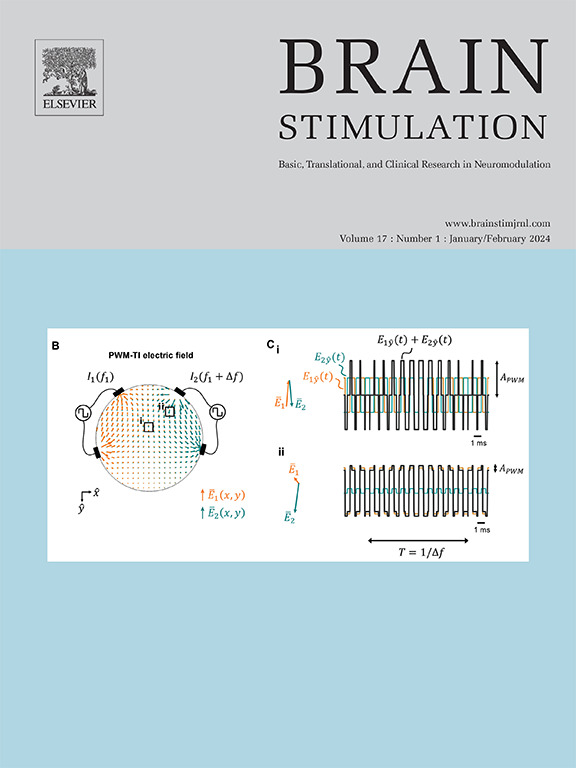迷走神经刺激疗法治疗难治性PTSD。
IF 7.6
1区 医学
Q1 CLINICAL NEUROLOGY
引用次数: 0
摘要
背景:创伤后应激障碍(PTSD)是一种常见且使人衰弱的疾病,许多个体对现有的治疗方法没有反应。我们开发了一种全新的基于神经调节的疗法来治疗难治性PTSD。这种方法的前提是结合长时间暴露疗法,这是一种一线循证认知行为疗法,指导恐惧网络的变化,同时提供迷走神经刺激(VNS)的短脉冲,增强突触可塑性。方法:我们进行了一项首次人体前瞻性开放标签早期可行性研究(EFS),使用下一代小型化系统对9名中度至重度治疗难治性PTSD患者进行VNS治疗。所有个体都接受了标准的12个疗程的长时间暴露治疗,并结合VNS。评估分别在治疗前、治疗后1周、治疗结束后1、3、6个月进行。临床试验:政府注册:NCT04064762。结果:与基线相比,VNS治疗导致PTSD症状和严重程度的多项指标显著改善,具有临床意义(治疗后cap -5、PCL-5和HADS均p < 0.001)。这些益处在停止治疗6个月后仍然存在,表明持续的改善。所有参与者在完成治疗后都表现出PTSD诊断的丧失。未观察到严重或意外的器械相关不良事件。结论:这些发现证明了VNS治疗PTSD的安全性和可行性,并强调了该方法的潜力。总的来说,这些都支持在严格的随机对照试验中VNS治疗PTSD的有效性。本文章由计算机程序翻译,如有差异,请以英文原文为准。
Vagus nerve stimulation therapy for treatment-resistant PTSD
Background
Posttraumatic stress disorder (PTSD) is common and debilitating, and many individuals do not respond to existing therapies. We developed a fundamentally novel neuromodulation-based therapy for treatment-resistant PTSD. This approach is premised on coupling prolonged exposure therapy, a first-line evidence-based cognitive behavioral therapy that directs changes within fear networks, with concurrent delivery of short bursts of vagus nerve stimulation (VNS), which enhance synaptic plasticity.
Methods
We performed a first-in-human prospective open-label early feasibility study (EFS) using a next-generation miniaturized system to deliver VNS therapy in nine individuals with moderate to severe treatment-resistant PTSD. All individuals received a standard 12-session course of prolonged exposure therapy combined with VNS. Assessments were performed before, 1 week after, and 1, 3, and 6 months after the completion of therapy. ClinicalTrials.gov registration: NCT04064762.
Results
VNS therapy resulted in significant, clinically-meaningful improvements in multiple metrics of PTSD symptoms and severity compared to baseline (CAPS-5, PCL-5, and HADS all p < 0.001 after therapy). These benefits persisted at 6 months after the cessation of therapy, suggesting lasting improvements. All participants showed loss of PTSD diagnosis after completing treatment. No serious or unexpected device-related adverse events were observed.
Conclusions
These findings provide a demonstration of the safety and feasibility of VNS therapy for PTSD and highlight the potential of this approach. Collectively, these support the validation of VNS therapy for PTSD in a rigorous randomized controlled trial.
求助全文
通过发布文献求助,成功后即可免费获取论文全文。
去求助
来源期刊

Brain Stimulation
医学-临床神经学
CiteScore
13.10
自引率
9.10%
发文量
256
审稿时长
72 days
期刊介绍:
Brain Stimulation publishes on the entire field of brain stimulation, including noninvasive and invasive techniques and technologies that alter brain function through the use of electrical, magnetic, radiowave, or focally targeted pharmacologic stimulation.
Brain Stimulation aims to be the premier journal for publication of original research in the field of neuromodulation. The journal includes: a) Original articles; b) Short Communications; c) Invited and original reviews; d) Technology and methodological perspectives (reviews of new devices, description of new methods, etc.); and e) Letters to the Editor. Special issues of the journal will be considered based on scientific merit.
 求助内容:
求助内容: 应助结果提醒方式:
应助结果提醒方式:


